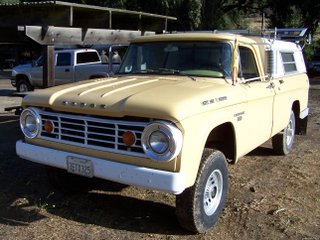| Subject: |
|
Re: ...in it for the long term... |
| Name: |
|
MoparNorm |
| Date Posted: |
|
Oct 30, 07 - 2:14 AM |
| IP Address: |
|
71.119.187.197 |
| Email: |
|
moparnorm@hotmail.com |
| Dodge-Link |
|
http://stores.ebay.com/All-Kinds-of-Surplus_W0QQcolZ4QQdirZ1QQfsubZ0QQftidZ1QQpZ2QQtZkm |
| Message: |
|
From Business Week
Chrysler Needs Hot Models
Chrysler's Jim Press admits that the automaker not only has to make better cars, it has to make fewer of them
by David Welch
Recently, new Chrysler Vice-Chairman and President James Press and Chief Executive Officer Robert Nardelli were watching inventory pile up on dealer lots. They reckoned the company needed some big production cuts to get stock in line with slipping sales.
So they had a conference call with one of the company's overseers at Cerberus Capital Management—which bought 80% of Chrysler this year—and told the private equity firm that Chrysler needed to cut production by 82,000 cars in the last three months of the year. That 16% drop adds up to about $1 billion in lost cash flow.
It took a seven-minute call to get it done. "At other companies," says Press, formerly Toyota's (TM) No. 2 North American executive, "it's a couple of months' process and a couple of flights across the Pacific."
Unrealistic Sales Expectations
Press's tale shows how tight a grip Cerberus has on Chrysler, but it also reveals that the private equity owner is willing to endure short-term losses while Chrysler's new management team works to restructure the company. It's just that sort of long-range thinking that Cerberus Chairman John Snow promised when announcing the acquisition in May.
Cutting production may seem like part of the basic nuts and bolts of running a carmaker, but it lies at the heart of what has been wrong with Chrysler and the U.S. car business. Up until recently, Chrysler's strategy was to go to market with unrealistic sales expectations, given the quality of its cars and weakness of its brands.
When sales fell short of projections, the company would keep building the cars and trucks, cajoling dealers to take them and find a way to sell them. If they couldn't, bigger rebates or unprofitable sales to rental fleets would follow. That build-and-they-will-buy mentality drove Chrysler's prices down and sent the company reeling into the red.
Producing to Demand
Says Press, who spoke to reporters in Las Vegas, where the company was meeting with its dealers, "Why would we keep building cars people don't want?" Now, he says, Chrysler is trying to retool the company so that its factories run closer to real sales.
That's what the Japanese automakers do. Toyota and Honda (HMC) have managed to build a string of factories that produce roughly what the car buying public demands. That means they can sell with lower rebates and fewer deals to auto rental fleets, and they get better prices for their cars.
Chrysler may have to keep using short-term production cuts while the company scrambles to design hotter models and engineer factories that can adjust to demand for different types of vehicles. The automaker's factories aren't yet flexible enough to build several different types of vehicles, cranking up production of one when another has slack sales. "They will probably have to right-size production," says Michael Robinet, vice-president of CSM Worldwide, an automotive consulting firm in Northville, Mich.
Big Spenders
Press admits that having better cars is the final driver. And Chrysler still has a lot of work to do. Many Chrysler models, including the new Chrysler Sebring midsize car, sit on the lot for an average of three months before consumers buy up the inventory, according to Edmunds.com, which tracks car pricing and sales data. Some models, like the new four-door Jeep Wrangler, are hot sellers and dealers are actually short on inventory.
There, too, Press says, Cerberus is helping out. The owner has boosted Chrysler's capital spending up above $3 billion to give the company more new models and improve existing ones. That has enabled Chrysler to make some 200 changes to current and existing cars.
Among the big changes is sprucing up the cabins and dashboards of Chrysler's cars, say company executives. Even before Cerberus took over, Chrysler realized that the interiors of its cars lacked the posh feel and creature comforts of some key rivals. During its due diligence, Cerberus's consultants came to the same conclusion. So the company is spending more to make its cars feel richer.
In It for the Long Haul
These days, everything is being done under the watchful eyes of Press and Nardelli. The two executives are digging into fine details of future products, even ordering up changes to cars that are already on the market, Press says.
Press also knows that Chrysler sells too many vehicles under different names that are basically the same car. The Dodge Durango and Chrysler Aspen SUVs both come to mind. In the long run, he says, Chrysler will cull lookalikes that chase the same buyers and add more unique models.
Those kind of improvements are what Chrysler will need to do long-term to boost sales. The plan is to endure profit-sapping production cuts while Chrysler retools its factories to be more flexible to adjust to market demands. Meanwhile, the company must race to build better cars.
"There's no silver bullet," Press says. "Over time you get closer to what it took Toyota 25 to 30 years to build." And over time, we'll see if Cerberus has that kind of patience.
Welch is BusinessWeek's Detroit bureau chief. |
|
Replies:
|
|
|
|
|









 Reply
Reply Home
Home bravenet.com
bravenet.com